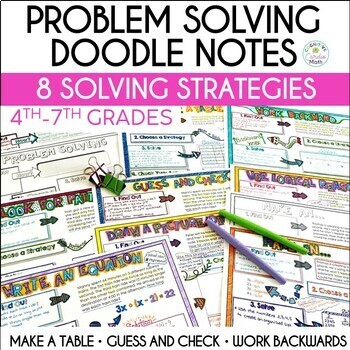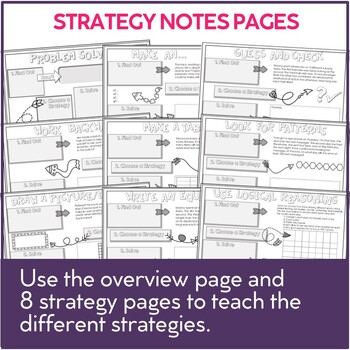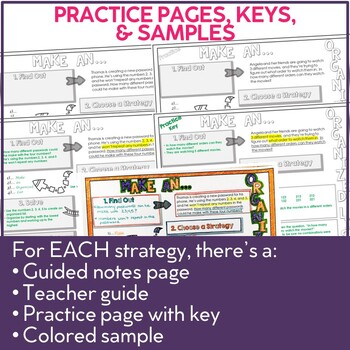Problem Solving Strategies Math Doodle Notes & Activities, 4th-7th Grade Math
- Zip
What educators are saying
Description
Math notes and activities for problem solving strategies are more engaging with the Doodle Note format! These problem solving notes and practice worksheets will help your students:
- Learn and retain eight different problem solving strategies
- Use symbols and color coding to help remember the strategies
- Get organized for problem solving
- Practice solving with the different strategies
Problem solving can be a challenge, but when students keep the notes in their math notebooks or binders as reference pages, they can refer to them all year for reminders and help.
Included in this easy-prep set of Problem Solving Strategies Doodle Notes:
1) A “main” problem solving page that lists the steps for problem solving, as well as the various strategies.
2) An introduction page for each of these 8 problem solving strategies, with a specific problem to solve and the steps to use the strategy, to solve the given problem:
- Make an Organized List
- Guess and Check
- Work Backward
- Make a Table
- Look for Patterns
- Draw a Picture/Diagram
- Write an Equation
- Use Logical Reasoning
3) A teaching guide/answer key for each strategy page
4) A practice page for each problem solving strategy, with answer key
5) A colored sample of each introduction page
6) An editable page with no title or problem, so you can add your own problems and titles for more practice – you can only ADD to the page; the template itself can’t be altered.
What teachers are saying about this problem solving strategies resource:
⭐️⭐️⭐️⭐️⭐️ “These are great for working through the different strategies. I am using a new one each week. My 6th graders love coloring them in when they are done.”
⭐️⭐️⭐️⭐️⭐️“This resource is perfect for the beginning of the year to set students up for success during the school year!”
⭐️⭐️⭐️⭐️⭐️“I used this resource to introduce each Problem-Solving strategy. This resources provides the background information, example problems, and the opportunity to model solutions and self-checking strategies. I then followed up with additional problems that utilized the same strategies.”
⭐️⭐️⭐️⭐️⭐️“Visually helped my students to understand how to read and solve word problem but more importantly they had fun doing it.”
Related Resources:
Problem Solving Math Wheels: a great partner for these problem solving notes pages are the , which can also be kept as a reference all year.
Math Word Problem Sets, 5th -6th Grades
Math Problem Solving, 6th-7th Grades
Problem Solving Strategies Bookmark
********************************************************************
You might also like:
4th-5th Grade Color by Number Bundle
4th-5th Grade Footloose Task Card Bundle
4th Grade Color by Number Mini Bundle
5th Grade Color by Number Mini-Bundle
5th Grade Math Doodle Wheel Bundle
5th-6th Grade Problem Solving Sets
6th Grade Spiral Math Review Daily Warm Ups
6th Grade Footloose Task Card Bundle
6th Grade Math Doodle Wheel Bundle
6th Grade Math Resource Bundle - resources for the entire year
********************************************************************
Please keep in touch by following me, to be notified when new products are uploaded! Resources are 1/2 off for the first 24 hours, so it pays to follow!
********************************************************************
Connect with Me:
Click HERE if you'd like to get freebies from me sent to your inbox.
*********************************************************************
Copyright © Cognitive Cardio Math
Permission to copy for single classroom use only.
Please purchase additional licenses if you intend to share this resource.





